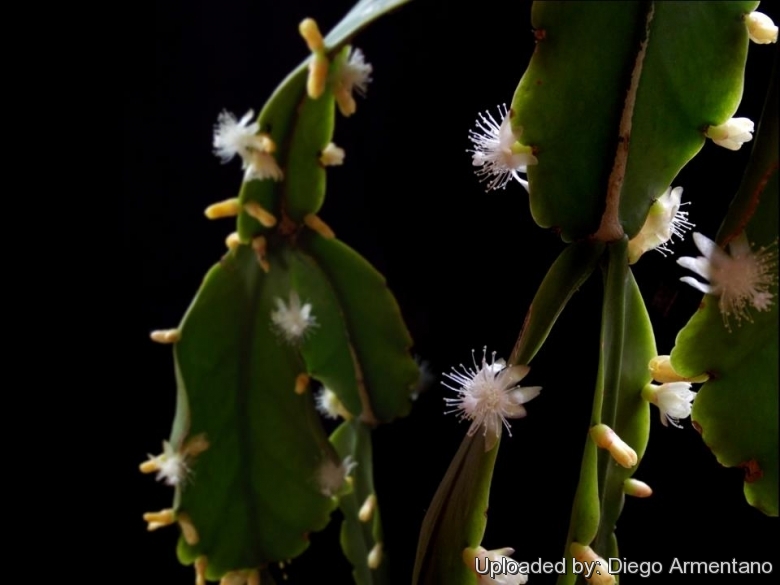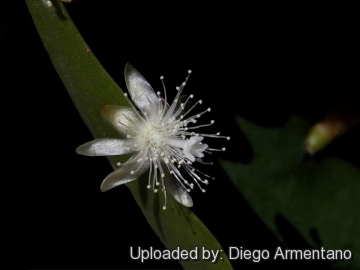
Rhipsalis pachyptera Photo by: Diego Armentano
Origin and Habitat: Rhipsalis pachypteraSN|7214]]SN|7214]] is endemic to Brazil, where it occurs in Paraná, Rio de Janeiro, Santa Catarina and São Paulo. Records from Rio Grande do Sul are probably a different species. This is a fairly common and locally abundant species.
Altitude range: It occurs from sea level to 1,500 metres above sea level, but it is more common at low elevations.
Habitat and Ecology: This cactus grows as a lithophyte and as an epiphyte on trunks of trees in mostly open habitat in Atlantic forest. The habitats, especially at lower levels, are threatened by expanding tourist developments, urbanization, Eucalyptus plantations and small-scale crop farming.
Synonyms:
See all synonyms of Rhipsalis pachyptera
back
Accepted name in llifle Database:Rhipsalis pachyptera Pfeiff.Enum. Diagn. Cact. 132. 1837Synonymy: 7
back
Common Names include:
PORTUGUESE (Português): Bico de Papagaio
Description: Rhipsalis pachyptera is an epiphytic or lithophytic succulent plant, semierect to somewhat pendent, spineless, freely branching, 0.7-1.5 m long. The stems are robust, with many large wide leaf-like joints that are often referred to as leaves. These flattened stems are broadly elliptic and leathery, pale fresh green to deep green in colour and sometimes tinged reddish. It is an outstanding species often developing many buds at one areole. Flower creamy-yellow or whitish followed by many white fruits. This species was for a long time confused with Rhipsalis alataSN|7214]]SN|7210]], a very distinct species from Jamaica, now referred to the genus Pseudorhipsalis. Rhipsalis pachypteraSN|7210]]SN|7214]] and Rhipsalis crispata are connected by numerous intermediate species whose classification is yet to be sorted out.
Stems: Much jointed, branching apically, rarerly laterally, branches dichotomous or verticillate, pendent, succulent, dimorphic, often terete below with many large wide stems segments above. Primary stem segments 8-40 cm long, 2-3 winged, with cylindric base 7-30 mm wide. Secondary stem segments flattened, thick, broadly elliptic, sometimes nearly circular, mostly with truncate apices (8-)11-25 cm long and 5-12 cm broad, thickish, stiff, dark green, becoming purple, and with prominent veins. Margin deeply crenate (with notched and scalloped ) plane to slightly undulate, with 6-16 mm projections. Sometimes two rows of aerial roots from the mid-vein.
Areoles: With sparse wool 1-5 cm apart. When sterile 2-3 mm in diameter, sometimes with vestigial scales; when fertile 2.8-4 mm in diameter, dense pilose, with one to several acicular scales.
Flowers: Numerous, rotate, sweet smelling, sessile, borne laterally from the scallops of the branches, solitary, or 2-5(-13) from the areole, with very short tube, to 12(-15) mm long, 13-25 mm in diameter. Petaloid tepals 5-9, asymmetric, widely spreading, 2.5-12 mm long 2.5-6 mm wide, greenish-white, yellowish or whitish external with reddish apex, apex rounded, curved inwards. Stamens 60-70, white. Style 6-7 mm long. Stigma-lobes (3-)4-5(-6), slender 1.7-3.5 mm long. Ovary subglobose, 4 mm long and thick, greenish, smooth with 1-4 sepaloid tepals. Nectary 1-1.3 mm long.
Blooming season: Winter.
Fruit: Globose, to depressed globose, 4.5-5 mm long and 5-5.5 mm wide, white, reddening in the sun (often pinkish or reddish when immature), glabrous.
Bibliography: Major references and further lectures
1) N. L. Britton, J. N. Rose: “The Cactaceae. Descriptions and Illustrations of Plants of the Cactus Family.” Volume 4, The Carnegie Institution of Washington, Washington 4: 7. 1923 [24 Dec 1923]
2) Edward Anderson “The Cactus family” Timber Press, Incorporated, 2001
3) Taylor, N.P. & Zappi, D. 2013. Rhipsalis pachyptera. The IUCN Red List of Threatened Species 2013: e.T152373A629695. http://dx.doi.org/10.2305/IUCN.UK.2013-1.RLTS.T152373A629695.en. Downloaded on 15 April 2016.
4) Clive Innes “Complete Handbook of Cacti and Succulents” Van Nostrand Reinhold Company, 01/dic/1981
5) Hunt, D., Taylor, N. and Charles, G. (compilers and editors). 2006. “The New Cactus” Lexicon. dh Books, Milborne Port, UK.
6) James Cullen, Sabina G. Knees, H. Suzanne Cubey "The European Garden Flora Flowering Plants: A Manual for the Identification of Plants Cultivated in Europe, Both Out-of-Doors and Under Glass" Cambridge University Press, 11/Aug/2011
7) Pfeiffer, L. “Enumeratio Diagnostica Cactearum.” Berolini: Sumtibus Ludovici Oehmigke. 1837.
8) Calvente, A. 2010. “Filogenia molecular, evolução e sistemática de Rhipsalis.” Ph. D. dissertation, São Paulo: Universidade de São Paulo.
 Rhipsalis pachyptera Photo by: Diego Armentano
Rhipsalis pachyptera Photo by: Diego Armentano Rhipsalis pachyptera Photo by: Diego Armentano
Rhipsalis pachyptera Photo by: Diego ArmentanoCultivation and Propagation: Rhipsalis pachypteraSN|7214]]SN|7214]] is among the easiest to cultivate epiphytic cacti and tolerates neglect. This forest cactus tends to be long lived, but appears to be rare in cultivation, where it needs some shade and high humidity to succeed.
Exposure: This plant (as with all Rhipsalis) prefers partial shade.
Watering: It requires ample summer water (more than other cacti), but allow soil to dry slightly between waterings.
Soil: These cacti won't want a normal cactus soil but will prefer to be in a soil largely composed of organic material, such as peat or sphagnum moss, This type of soil would normally be used for orchids, bromeliads or other epiphytic plants.
These forest cacti tend to be long lived.
Hardiness: Frost tender. It needs night-time temperatures no cooler than 5° C, especially in the winter.
Special requirements: These plants bloom profusely if grown in an even, high temperature, but significantly less if the temperature fluctuates between 4°C and 18°C. They drop their buds easily if they are moved. Once flower buds have formed, do not move the plant, as slight changes in environment may cause the buds to drop.
Propagation: Stem cuttings.













